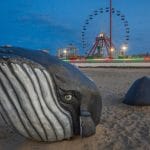Top 10 Glaciers in the World
by Nabewise

Glaciers are the largest and biggest source of freshwater on this planet. They are formed when snow falls at a very fast rate and condenses to form a sheet of ice. This post is the 1st part of Top 10 Glaciers in the World.
Hubbard Glacier
The Hubbard Glacier is one of the largest glaciers in the world and is located between the State of Alaska and Yukon Bay in Canada. It is also the largest tidewater glacier in North America and is the scene of the second largest glacial lake outburst in recent times.
Did you know that the Hubbard Glacier is one of the most rapidly changing glaciers worldwide?
The Hubbard Glacier has been retreating at a rate of 3.4 kilometers per year since 2008, and in just over 100 years it will have retreated all the way to Yakutat Bay. That's right! This glacier will be gone if something doesn't change soon.
Perito Moreno Glacier
The Perito Moreno Glacier is one of the few glaciers in the world that seems to be increasing in size despite the effects of global warming. It is located in Argentina and is one of the most popular tourist destinations in the country. It is over 30 kilometres in length and is believed to be the 3rd largest source of freshwater in the world.
The Perito Moreno Glacier in Argentina is one of the most well-known glaciers around. It's also one of the fastest retreating glaciers in all of South America, and it has been shrinking at an alarming rate for over a century. The glacier itself is located within Lago Argentino, nearly 7 miles away from where it once was back when people first discovered it in 1891. You can still see this for yourself today by taking a boat ride to the front edge of the glacier which will provide you with some breathtaking views that are unmatched by any other place on earth!
The Perito Moreno Glacier is home to what many call “the world's largest ice mass.” Being able to see these massive chunks (some as big as 25 meters
Vatnajökull
The Vatnajökull glacier is located in Iceland and covers about 10% of the country. It is the largest glacier in Europe and has many active and un-active volcanoes beneath its icy surface. The recent eruption of the Eyjafjallajokull volcano is an example of the devastation these snowy surfaces hide.
Vatnajökull is the largest glacier in Iceland and has been melting at an alarming rate. The ice caps are now shrinking by about 1% per year, which means that every summer there's a little less of it left to enjoy. This blog post will explore some of the interesting facts about this natural wonder, including its size, what makes Vatnajökull unique among glaciers, how much glacial ice melts each year, and why you should care.
Glaciers of Kilimanjaro
The Glaciers of Kilimanjaro may not be among the largest in the world but are truly among the most magnificent in the world. Although these glaciers are fast retreating, they are a source of major tourist attraction in Africa.
The glaciers of Kilimanjaro are melting. This is not good news. It has been reported that the ice on top of Africa's tallest mountain will be gone in 15 years, if something isn't done to help it cool down. So what should we do?
Siachen Glacier
The Siachen Glacier is located in the Himalayan range and falls entirely along the Indian side of the India-Pakistan LOC. It has been a source of major conflict between the two nations as this glacier provides a unique vantage position to whoever controls it. It also boasts of the world’s highest helipad. It is also one of the largest sources of freshwater to the Indian people.
The Siachen Glacier is the world's highest glacier, and it's also one of the coldest. Literally. It has an average yearly temperature of -30 degrees Fahrenheit (-34 Celsius). In fact, scientists say that this glacier is so cold that water on top freezes as soon as it touches the surface! But don't worry- if you're going to visit any time soon, your trip will be a little warmer than usual because there are no visitors allowed due to the current conflict between India and Pakistan.
Heard Island Glacier
This not so famous glacier is located in the sub Antarctic region close to Australia and is one of the few glaciers that are isolated from global warming. According to scientists, it is an ideal site for setting up a laboratory to do research work on glacial warming.
The Heard Island Glacier is a big, blue glacier. It's the second-largest of the Antarctic glaciers and it's also pretty darn close to being as long as it is wide. The area that this glacier covers has been shrinking rapidly over the last couple decades with some places losing about 10% in just one year!
Lambert Glacier
The Lambert Glacier in Antarctica is over 400 kilometres long and 100 kilometres wide, making it the largest glacier in the world. This glacier has been slowly melting giving us an insight to how global warming affects these massive ice sheets and in turn how much sea levels are raised.
We all know that glaciers are slowly melting, but did you know that the Lambert Glacier in Antarctica is completely gone? This glacier was once one of the world's largest and most stable ice masses, but now it has melted into nothing. Scientists believe this to be due to warmer temperatures at high altitudes which cause snowfall accumulation rates to decrease. The thermal conductivity of water also plays a role in how quickly the glacier melts. If there are more open spaces between ice crystals then it will take longer for heat from below to escape, thus causing an increase in temperature at higher levels within the ice mass. This is one explanation for why glaciers are melting faster than ever before! You can learn more about what's happening with these beautiful wonders by reading
Glacier Bay
Although not an individual glacier, the Glacier Bay in Alaska is home to a number of glacial ice sheets. The Glacier Bay is home to around 16 glaciers although most of the ice on these is again receding, mainly due to global warming.
The glaciers are melting. You can see it in the pictures of bare rock and open water, but you can also feel it in your bones when you're standing on a beach that used to be covered with ice. It's hard to know what this means for our future, but one thing is certain: we need to learn more about how these massive bodies of ice behave so we can better predict their path and speed. Luckily there are people dedicated to studying these giants – like glaciologist Dr. Malcolm McMillan – who have spent decades collecting data from hundreds of field sites around the world, including at Glacier Bay National Park in Alaska. After 25 years working at Glacier Bay he still gets excited every time he sees a new iceberg calve into the
Pasterze Glacier
The Pasterze Glacier in Austria is the longest glacier in the Eastern Alps and is about 8.4 kilometres in length. It lies directly underneath the highest mountain in Austria. It is one of the fastest retreating glaciers in the world with its length decreasing by around 10 metres each year.
Pasterze Glacier is the largest glacier in Austria and one of the biggest glaciers in Europe. It is located at an altitude of 2,500 meters on a mountain top near Zell am See, Salzburg. The Pasterze Glacier has been shrinking for decades due to global warming.
Pasterze Glacier’s surface area has shrunk by about 20% since 1850, with its thickness decreasing from up to 300 meters during that time to less than 100 meters today.
The rate of retreat was about two inches per day until 1997 when it suddenly accelerated to five feet per day!
This sharp increase can be attributed to climate change caused by human activity such as deforestation, cattle grazing and burning fossil fuels which have all
Jostedalsbreen
Jostedalsbreen glacier is the largest glacier in Europe located in Southern Norway. With a length of over 60 kilometres, it is part of the Jostedalsbreen National Glacier Park and almost covers half of the park. This glacier too has been steadily retreating year by year.
The glaciers in Norway are some of the most fascinating places on earth. The Jostedalsbreen glacier is one of them, and it's so big that you can ski all the way across it. But since this blog post is about my favorite Norwegian glacier, I'm not going to tell you much more than that! Stay tuned for next week when we'll be talking all about Svartisen glacier.




